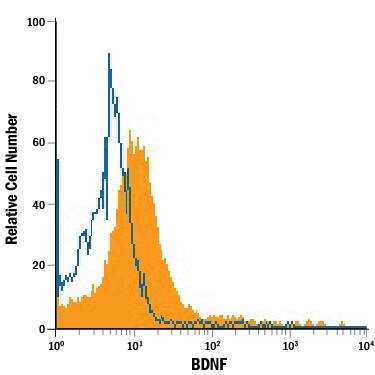Human BDNF APC-conjugated Antibody
R&D Systems, part of Bio-Techne | Catalog # IC2481A


Key Product Details
Species Reactivity
Applications
Label
Antibody Source
Product Specifications
Immunogen
His129-Arg247
Accession # P23560
Specificity
Clonality
Host
Isotype
Scientific Data Images for Human BDNF APC-conjugated Antibody
Detection of BDNF in U‑87 MG Human Cell Line by Flow Cytometry.
U-87 MG human glioblastoma/astrocytoma cell line was stained with Mouse Anti-Human BDNF APC-conjugated Monoclonal Antibody (Catalog # IC2481A, filled histogram) or isotype control antibody (Catalog # IC002A, open histogram). To facilitate intracellular staining, cells were fixed and permeabilized with FlowX FoxP3 Fixation & Permeabilization Buffer Kit (Catalog # FC012). View our protocol for Staining Intracellular Molecules.Applications for Human BDNF APC-conjugated Antibody
Intracellular Staining by Flow Cytometry
Sample: U‑87 MG human glioblastoma/astrocytoma cell line fixed with Flow Cytometry Fixation Buffer (Catalog # FC004) and permeabilized with Flow Cytometry Permeabilization/Wash Buffer I (Catalog # FC005)
Formulation, Preparation, and Storage
Purification
Formulation
Shipping
Stability & Storage
- 12 months from date of receipt, 2 to 8 °C as supplied.
Background: BDNF
Brain-derived neurotrophic factor (BDNF) is a member of the NGF family of neurotrophic factors (also named neurotrophins) that are required for the differentiation and survival of specific neuronal subpopulations in both the central as well as the peripheral nervous system. The neurotrophin family is comprised of at least four proteins including NGF, BDNF, NT-3, and NT-4/5. These secreted cytokines are synthesized as prepropeptides that are proteolytically processed to generate the mature proteins. All neurotrophins have six conserved cysteine residues that are involved in the formation of three disulfide bonds and all share approximately 55% sequence identity at the amino acid level. Similarly to NGF, bioactive BDNF is predicted to be a non-covalently linked homodimer.
BDNF cDNA encodes a 247 amino acid precursor protein with a signal peptide and a proprotein that are cleaved to yield the 119 amino acid mature BDNF. The amino acid sequence of mature BDNF is identical in all mammals examined. High levels of expression of BDNF have been detected in the hippocampus, cerebellum, fetal eye, and placenta. In addition, low levels of BDNF expression are also found in the pituitary gland, spinal cord, heart, lung, and skeletal muscle. BDNF binds with high affinity and specifically activates the TrkB tyrosine kinase receptor.
References
- Eide, F.F. et al. (1993) Exp. Neurol. 121:200.
- Snider, W.D. (1994) Cell 77:627.
- Barbacid, M. (1994) J. Neurobiol. 25:1386.
Long Name
Alternate Names
Gene Symbol
UniProt
Additional BDNF Products
Product Documents for Human BDNF APC-conjugated Antibody
Product Specific Notices for Human BDNF APC-conjugated Antibody
For research use only